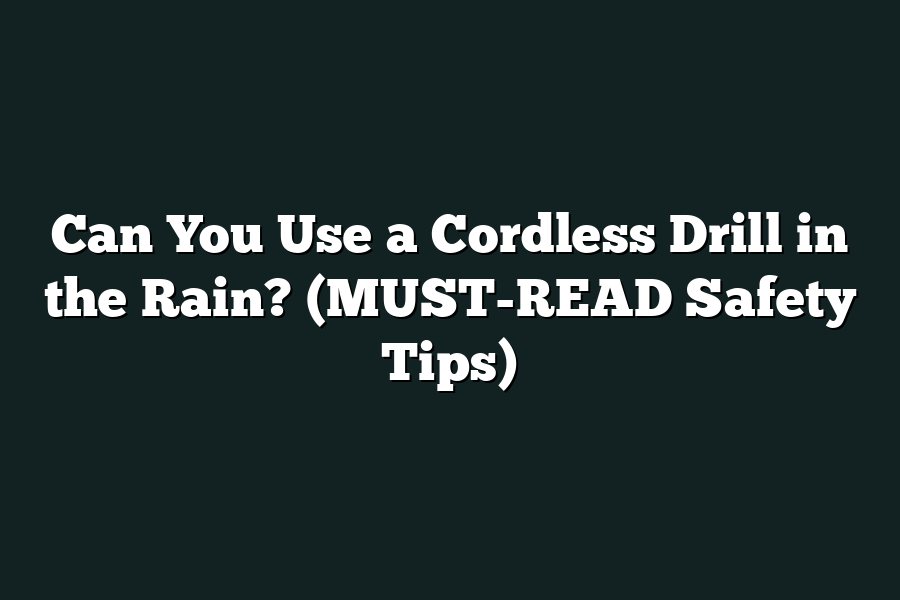Using a cordless drill in the rain is not recommended as it can pose a safety hazard due to the risk of electric shock. Water can damage the internal components of the drill and compromise its functionality. To prevent accidents and equipment damage, it’s best to avoid using any power tools, including cordless drills, in wet conditions and ensure they are stored in a dry place.
Are you tempted to use a cordless drill in the rain during a DIY project?
Before you do, it’s vital to grasp the risks.
In this guide, I’ll cover water and electricity dangers, offer drill protection tips, discuss safety precautions, and share what to do if your drill gets wet.
Stay safe and productive during your rainy-day projects.
Table of Contents
Understanding the Dangers of Water and Electricity Combination
When it comes to using a cordless drill in the rain, one of the critical factors to consider is the potential dangers posed by the combination of water and electricity.
Let’s delve into why this is a risky endeavor that should be approached with caution.
The Risks of Electric Shock
Electricity and water are a dangerous mix.
When water comes into contact with an electric current, it becomes a conductor of electricity, increasing the risk of electric shock.
In fact, according to the National Fire Protection Association, between 2014-2018, U.S. fire departments responded to an estimated average of 24,600 home structure fires involving electrical distribution or lighting equipment per year.
Potential Damage to the Cordless Drill
Exposing a cordless drill to water can also lead to irreversible damage.
Water can seep into the internal components of the drill, causing rust, corrosion, and short circuits.
Even if the drill appears to be working fine initially, the long-term effects of water exposure can compromise its functionality and pose safety hazards down the line.
Impact on Battery Performance
Water and moisture can significantly impact the performance of the battery in a cordless drill.
Moisture can seep into the battery cells, leading to corrosion and reduced capacity.
This can not only shorten the lifespan of the battery but also increase the risk of overheating and malfunction during use.
Safety Precautions to Take
To mitigate the risks associated with using a cordless drill in wet conditions, it’s important to take some safety precautions.
Firstly, always check the weather forecast before starting any outdoor drilling tasks.
If rain is on the horizon, it’s best to postpone the job until conditions are dry.
Additionally, invest in a waterproof cover for your cordless drill to protect it from unexpected drizzles or splashes.
When storing your drill, ensure it is kept in a dry and secure location to prevent water damage.
By understanding the dangers of combining water and electricity, as well as implementing safety measures to protect your equipment, you can ensure a safe and efficient drilling experience every time.
Remember, when it comes to working with power tools, safety should always be the top priority.
Tips for Protecting Your Cordless Drill from Water Damage
As tempting as it may be to power through a rainy day DIY project, using a cordless drill in the rain can pose serious risks to both the tool’s functionality and your safety.
To help you navigate this issue, here are some essential tips for protecting your cordless drill from water damage:
Keep it Covered
One of the simplest yet most effective ways to shield your cordless drill from water damage is to ensure it’s always covered when not in use.
Whether you opt for a dedicated tool bag, a waterproof container, or a DIY solution, keeping your drill protected from the elements can significantly extend its lifespan.
Choose the Right Drill for the Job
When working in potentially wet conditions, selecting a cordless drill with a high IP (Ingress Protection) rating can make all the difference.
Look for drills with an IPX4 rating or higher, indicating that they are splash-proof and can handle light rain without sustaining damage.
Use Protective Accessories
Investing in additional protective accessories, such as a drill holster with a weather-resistant cover or a silicone boot that wraps around the tool, can provide an extra layer of defense against water infiltration.
These accessories not only help keep your drill dry but also contribute to a more secure grip in slippery conditions.
Store Correctly
Proper storage is key to preventing water damage to your cordless drill.
When not in use, store your drill in a dry, sheltered area away from moisture and humidity.
Additionally, periodically inspect and clean the drill’s battery compartment and charging port to remove any traces of moisture buildup.
Dry Thoroughly After Use
If your cordless drill does come into contact with water, it’s crucial to dry it thoroughly before storing it away.
Use a dry cloth to wipe down the exterior and carefully remove any moisture from crevices or battery contacts.
Allowing the drill to air dry before use can help prevent internal corrosion and electrical malfunctions.
Exercise Caution
Above all, exercise caution and common sense when considering whether to use a cordless drill in wet conditions.
If the weather is inclement or there’s a risk of water exposure, it’s best to postpone your project rather than risk damage to your tool or potential safety hazards.
By following these tips and taking proactive measures to protect your cordless drill from water damage, you can ensure that your tool remains in top condition and ready for use whenever you need it.
Remember, a little prevention can go a long way in preserving the longevity of your equipment.
Safety Precautions to Consider Before Using a Cordless Drill in the Rain
When it comes to using a cordless drill in the rain, there are several safety precautions that must be considered to ensure both your safety and the longevity of your tool.
In this section, I will outline key safety measures that you should keep in mind before braving wet weather conditions with your cordless drill.
1. Water Resistance Rating of the Cordless Drill
Before taking your cordless drill out in the rain, it’s essential to check the water resistance rating of the tool.
Most cordless drills come with an IP (Ingress Protection) rating that indicates the level of protection the tool has against moisture and dust.
For example, a drill with an IPX4 rating is splash resistant, meaning it can withstand water splashes from any direction.
However, a higher rating like IPX7 offers protection against immersion in water up to a certain depth.
Always refer to the manufacturer’s specifications to determine the water resistance capability of your cordless drill.
2. Inspect the Drill for Damages and Wear
Before using your cordless drill in wet conditions, thoroughly inspect the tool for any damages or signs of wear that could compromise its safety.
Check the battery, casing, and connections for any cracks, exposed wires, or other issues that could allow water to penetrate the device.
Using a damaged drill in wet conditions not only poses a safety risk but can also lead to irreparable damage to the tool.
3. Use a Ground Fault Circuit Interrupter (GFCI) Outlet
When working with power tools in wet environments, it’s crucial to use a Ground Fault Circuit Interrupter (GFCI) outlet to minimize the risk of electric shock.
A GFCI outlet monitors the flow of electricity and quickly shuts off power if it detects a ground fault or current leakage, protecting you from potential electrical hazards.
Always plug your cordless drill into a GFCI-protected outlet when using it in the rain to ensure your safety.
4. Wear Insulated Gloves and Boots
To further protect yourself while using a cordless drill in the rain, consider wearing insulated gloves and boots to prevent electric shock in case of accidental contact with water.
Insulated rubber gloves and boots provide an additional barrier between you and the electric current, reducing the risk of injury.
Additionally, wearing non-slip footwear will help prevent slips and falls on wet surfaces, ensuring a safer working environment.
5. Maintain a Firm Grip on the Drill
In wet conditions, surfaces can become slippery, making it challenging to maintain a firm grip on your cordless drill.
To prevent accidental drops or mishaps, ensure you have a secure grip on the tool at all times.
Consider using a tool lanyard or wrist strap to tether the drill to your wrist, providing an extra layer of security in case you lose control of the device.
By taking these safety precautions into account before using a cordless drill in the rain, you can minimize the risks associated with working in wet conditions and ensure a safe and efficient drilling experience.
Remember, safety should always be a top priority when using power tools, especially in challenging weather conditions like rain.
What to Do If Your Cordless Drill Gets Wet
You’re in the middle of a project, dark clouds roll in, and suddenly you find yourself working in the rain with your cordless drill.
It happens to the best of us.
But what should you do if your trusty tool gets wet?
Here are some steps to take to ensure your cordless drill stays in top shape:
Assess the Situation
First things first, make sure you’re safe.
Confirm that you’re not standing in water or any other hazardous conditions.
Once you’re in a safe spot, assess how wet your cordless drill actually is.
Is it just a few drops, or did it take a full-blown plunge into a puddle?
Power Down Immediately
If your cordless drill has gotten wet, the first step is to power it down immediately.
Remove the battery and any other power source to prevent any potential short circuits or damage.
Dry Thoroughly
Grab a clean, dry cloth and start drying off the exterior of the cordless drill.
Pay special attention to any crevices or openings where water may have seeped in.
Avoid using heat sources like hairdryers, as excessive heat can damage the internal components.
Disassemble and Inspect
If you’re comfortable doing so (and if your drill’s warranty allows), consider disassembling the drill to inspect the internal components.
Look for any signs of water damage, corrosion, or rust.
Allow Time to Air Dry
After drying off the exterior and inspecting the internal components, give your cordless drill some time to air dry completely.
Placing it in a well-ventilated area for at least 24 hours should ensure that all moisture evaporates.
Test Before Use
Before attempting to use the drill again, perform a test to ensure that it’s functioning properly.
Reassemble the components, insert the battery, and test the drill in a safe, controlled environment.
Seek Professional Help if Needed
If you’re unsure about the extent of the damage or if the drill is not working properly after drying, don’t hesitate to seek professional help.
A trained technician can assess the damage and recommend the necessary repairs.
By following these steps, you can increase the chances of saving your cordless drill from water damage.
Remember, prevention is always better than a cure, so whenever possible, avoid using your cordless drill in rainy or wet conditions to prevent potential damage.
Final Thoughts
Using a cordless drill in the rain can pose significant risks due to the dangerous combination of water and electricity.
By understanding the potential dangers and implementing precautionary measures to protect your tool from water damage, you can ensure both your safety and the longevity of your equipment.
Remember, safety should always come first when working with power tools.
If your cordless drill does get wet, take immediate action to prevent any further damage.
Stay informed, stay safe, and remember – a little caution goes a long way in safeguarding yourself and your tools.
So, next time you’re considering braving the rain with your cordless drill, think twice and prioritize safety above all else.
Stay dry, stay safe, and happy drilling!

